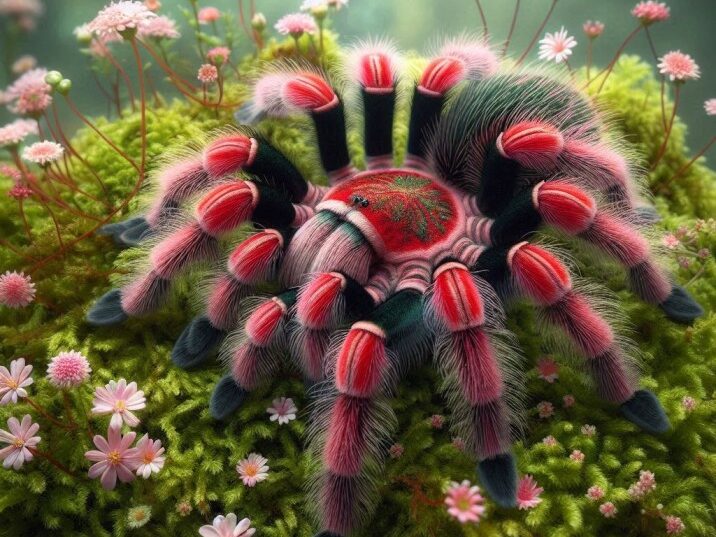Keeping tarantulas as pets is becoming increasingly popular, especially among spider enthusiasts. Tarantulas are fascinating creatures with unique behaviors and low maintenance requirements. However, choosing the right species can be challenging, especially for beginners. In this article, we will explore the easiest tarantula to keep in the UK, providing detailed information and guidance to help you make an informed decision.

Introduction
Table of Contents
Tarantulas are exotic pets that have intrigued many due to their unique appearance and relatively simple care needs. For those in the UK considering their first tarantula, it’s crucial to choose a species that is not only easy to care for but also docile and less prone to stress.
What Makes a Tarantula Easy to Keep?
Before diving into specific species, it’s important to understand what characteristics make a tarantula easy to keep. Here are some key factors:
- Temperament: A calm and docile tarantula is easier to handle and less likely to bite.
- Size: Smaller tarantulas are generally easier to house and manage.
- Hardiness: Some tarantulas are more resilient to environmental changes and less prone to health issues.
- Diet: A tarantula with a simple and easily manageable diet is preferable.
- Longevity: Tarantulas with longer lifespans allow for a longer-term commitment.
Easiest Tarantula to keep in the UK
1. Chilean Rose Tarantula (Grammostola rosea)
Care Requirements:
- Habitat: A simple enclosure with dry substrate, a hide, and a shallow water dish.
- Temperature and Humidity: They thrive at room temperature (65-80°F) with low humidity (50-60%).
- Diet: They primarily eat crickets, mealworms, and occasionally small roaches.
Why It’s Easy: Their docile nature, minimal care requirements, and adaptability to various environments make them an excellent choice for beginners.
2. Mexican Redknee Tarantula (Brachypelma hamorii)
Care Requirements:
- Habitat: They need a terrarium with a dry substrate, hiding places, and a water dish.
- Temperature and Humidity: They prefer temperatures between 70-85°F and moderate humidity levels (60-70%).
- Diet: A diet of crickets, mealworms, and other small insects is suitable.
Why It’s Easy: They are hardy, slow-moving, and rarely display aggression, making them ideal for new tarantula keepers.
3. Curly Hair Tarantula (Tliltocatl albopilosus)
Description: Known for their curly hair, the Curly Hair Tarantula is another favorite among beginners due to their calm nature and easy maintenance.
Care Requirements:
- Habitat: A simple setup with coconut fiber or peat moss substrate, a hide, and a water dish.
- Temperature and Humidity: Optimal temperatures range from 70-85°F with humidity around 65-75%.
- Diet: They are not picky eaters and will consume crickets, roaches, and mealworms.
Why It’s Easy: Their resilience, ease of care, and calm temperament make them perfect for novice tarantula owners.
Essential Care Tips for Beginner Tarantula Keepers
Housing Your Tarantula
When setting up a home for your tarantula, consider the following:
- Enclosure Size: A small to medium-sized tank is sufficient. Ensure it is escape-proof.
- Substrate: Use a substrate that retains moisture without becoming too wet. Coconut fiber or peat moss is ideal.
- Hiding Places: Provide hides where your tarantula can retreat and feel secure.
- Water Dish: Always keep a shallow water dish in the enclosure.
Feeding Your Tarantula
Feeding your tarantula is straightforward:
- Diet: Offer a variety of insects such as crickets, mealworms, and roaches.
- Feeding Schedule: Young tarantulas (spiderlings) should be fed more frequently (every 2-3 days), while adults can be fed once a week.
- Handling Prey: Remove uneaten prey after 24 hours to prevent stress or harm to your tarantula.
Handling Your Tarantula
While tarantulas are generally not meant for handling, some species tolerate it better than others:
- Gentle Species: Chilean Rose and Mexican Redknee tarantulas are more likely to tolerate gentle handling.
- Minimize Stress: Handle your tarantula infrequently to avoid stress.
- Safety First: Always be cautious and use a soft brush to coax your tarantula if necessary.
Health and Well-being
Maintaining your tarantula’s health involves:
- Regular Monitoring: Check for signs of molting, which is when your tarantula sheds its exoskeleton to grow.
- Environment: Keep the enclosure clean and maintain the appropriate temperature and humidity.
- Veterinary Care: Consult a vet experienced with exotic pets if you notice any health issues.
Table of Information
| Tarantula Species | Temperament | Habitat Requirements | Diet | Lifespan |
|---|---|---|---|---|
| Chilean Rose | Docile | Dry substrate, hide, water dish | Crickets, mealworms | 15-20 years |
| Mexican Redknee | Calm | Dry substrate, hide, water dish | Crickets, mealworms | 20-30 years |
| Curly Hair | Calm | Coconut fiber, hide, water dish | Crickets, roaches | 10-15 years |
Conclusion
Choosing the easiest tarantula to keep in the UK involves considering factors like temperament, care requirements, and hardiness. The Chilean Rose, Mexican Redknee, and Curly Hair Tarantulas are excellent choices for beginners due to their docile nature and straightforward care needs. By following the tips provided, you can ensure a happy and healthy environment for your tarantula, making your pet-keeping experience enjoyable and rewarding.
FAQs About Tarantula Easy to Keep
1. What is the best beginner tarantula for kids?
The Chilean Rose Tarantula is highly recommended for kids due to its calm and gentle nature.
2. How often should I feed my tarantula?
Young tarantulas should be fed every 2-3 days, while adults can be fed once a week.
3. Can tarantulas be handled?
While not all tarantulas enjoy handling, species like the Mexican Redknee are more tolerant of gentle handling.
4. What should I do if my tarantula is not eating?
It’s normal for tarantulas to go through fasting periods, especially before molting. Ensure their environment is optimal and consult a vet if the fasting continues.
5. How long do tarantulas live?
Depending on the species, tarantulas can live from 10 to 30 years. Mexican Redknee Tarantulas are known for their long lifespan, sometimes exceeding 30 years.

